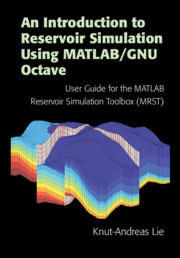 An Introduction to Reservoir Simulation Using MATLAB/GNU Octave
An Introduction to Reservoir Simulation Using MATLAB/GNU Octave from Part II - Single-Phase Flow
Published online by Cambridge University Press: 22 July 2019
This chapter explains how the mathematical models from Chapter 4 are implemented and integrated to form a full simulator. To this end, we introduce data structures to represent fluid behavior, the reservoir state, boundary conditions, source terms, and wells. We then explain in detail how the two-point flux approximation (TPFA) scheme is implemented in MRST for general unstructured grids. We also outline the basic solver used to compute time-of-flight and tracer partitions. We end the chapter by presenting a few examples that demonstrate how to set up simulations in MRST and set appropriate boundary conditions, source terms, or well models. The examples include the famous quarter-five spot problem, a corner-point grid with four intersecting faults, and a model of a shallow-marine reservoir (SAIGUP).
To save this book to your Kindle, first ensure [email protected] is added to your Approved Personal Document E-mail List under your Personal Document Settings on the Manage Your Content and Devices page of your Amazon account. Then enter the ‘name’ part of your Kindle email address below. Find out more about saving to your Kindle.
Note you can select to save to either the @free.kindle.com or @kindle.com variations. ‘@free.kindle.com’ emails are free but can only be saved to your device when it is connected to wi-fi. ‘@kindle.com’ emails can be delivered even when you are not connected to wi-fi, but note that service fees apply.
Find out more about the Kindle Personal Document Service.
To save content items to your account, please confirm that you agree to abide by our usage policies. If this is the first time you use this feature, you will be asked to authorise Cambridge Core to connect with your account. Find out more about saving content to Dropbox.
To save content items to your account, please confirm that you agree to abide by our usage policies. If this is the first time you use this feature, you will be asked to authorise Cambridge Core to connect with your account. Find out more about saving content to Google Drive.